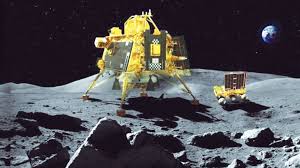Manas Dasgupta
NEW DELHI, Aug 22: The nation is bracing herself up to go through the most agonizing twenty minutes on Wednesday when the Vikram lander goes in to attempt a soft landing on the moon surface and create history.
India’s Chandrayaan-3 is all set to attempt a soft landing by the Vikram Lander with the Pragyaan rover in its belly near the moon’s South Pole. The nail-biting last twenty minutes of its journey are often described as “twenty minutes of terror” that could take a quantum jump in India’s space science.
A day before the crucial soft landing of the Chandrayaan-3 Lander Module on the Moon surface, the Indian Space Research Organisation (ISRO) said on Tuesday that the mission was on schedule. The ISRO posted on social media platform X: “The mission is on schedule. Systems are undergoing regular checks. Smooth sailing is continuing. The Mission Operations Complex (MOX) is buzzed with energy & excitement!”
The lander, with the rover in its belly, is in 25 km x 134 km orbit. It is set to land on the Moon on August 23 around 6.04 p.m. IST. Powered descent is expected to commence around 5.45 p.m. The MOX at ISRO Telemetry, Tracking, and Command Network (ISTRAC) in Bengaluru will oversee the complex soft landing of the Lander Module. A live telecast of the landing operation will begin at 5.20 p.m. IST on Wednesday.
Apart from ISTRAC, the Indian Deep Space Network (IDSN) antenna at Byalalu near Bengaluru, and the ground stations of the National Aeronautics and Space Administration (NASA) and the European Space Agency (ESA) will also be supporting the ISRO in the complex landing operation. The ESA’s 35-metre deep space antenna in New Norcia, Australia, a third ground station in the ESTRACK network, has been set up to track and communicate with the Lander Module during the lunar descent phase.
The New Norcia antenna will serve as a back-up for ISRO’s own ground station during the descent. It will receive information about the Lander Module’s health, location and trajectory in parallel with the ISRO station.
NASA’s Deep Space Network will be providing telemetry and tracking coverage during the powered descent phase from Deep Space Station (DSS)-36 and DSS-34 at Canberra Deep Space Communications Complex, followed by DSS-65 at Madrid Deep Space Communications Complex.
On August 22, ISRO shared images of the Moon captured by the Lander Position Detection Camera (LPDC) from an altitude of about 70 km. The space agency explained that ‘LPDC images assist the Lander Module in determining its position (latitude and longitude) by matching them against an on-board moon reference map.’
On the day of landing, the “twenty minutes of terror” would begin around 5.45 P.M. On commands from Bengaluru, the Vikram lander will begin its descent towards the moon surface from an altitude of 25 km.
In a powered descent, the Vikram lander will start hurtling towards the moon surface at a velocity of 1.68 km per second which is nearly 6048 km per hour -which is almost ten times the velocity of an airplane. Vikram lander will then slow down with all its engines firing – but the lander is still almost horizontal to the surface of the moon – this is called the rough braking phase which lasts for about 11 minutes.
Through some manoeuvers, the Vikram lander will be made vertical to the moon surface, with this begins the ‘fine braking phase.’ It was in the fine braking phase, when the Vikram lander during the Chandrayaan-2 launch went out of control and tumbled to a crash.
At 800 meters above the moon surface, both the horizontal and vertical velocities come to zero and the Vikram lander hovers above the lunar surface surveying the landing strip. The Vikram lander goes down further to stop to hover once again at 150 meters taking images for hazard detection and searching for the best landing site.
It will then touch down on the lunar surface with just two engines firing and the legs have been designed to take a maximum impact of 3m/second or about 10.8 km per hour. Once the sensors on the legs feel the lunar surface, the engines will shut down ending the twenty minutes of terror.
The lunar dust called regolith that is raked up by the landing is allowed to move away and settle down. Subsequently the ramp opens up. The Pragyaan Rover is slowly rolled down. Once the Pragyaan Rover reaches the lunar surface and the rover is then free to move around the lunar surface.
The big moment arrives when the Vikram lander takes images of the rover and the Pragyaan rover takes images of the lander, the first selfies by India from the lunar surface are beamed back to India. Now the real science can begin, the Vikram lander and rover are both solar-powered and are made to last one lunar day – which is equal to 14 Earth days.
After a majestic lift-off, ISRO’s Bahubali rocket or the launch vehicle, Mark-3, put Chandrayaan-3 in the orbit on July 14. Chandrayaan-3 took many elliptic circles of the Earth gaining velocity. On August 1, Chandrayaan-3 was nudged towards the moon on its 3.84 lakh km journey. On August 5, the Chandrayaan-3 satellite gently entered the moon’s orbit and settled in. In the moon’s orbit, the Chandrayaan-3 was stabilised for many days.
In a crucial and tricky maneuverer, the propulsion module and the Vikram lander with Pragyaan rover separated on August 17 – when the satellite was in a 153 km by 163 km orbit. The Propulsion module continues its journey around the moon in a 153 km by 163 km orbit.
Soon, the Vikram lander is brought closer to the moon surface in a 134 km by 25 km elliptical orbit before the powered descent can begin. Till here, India has done this process successfully in Chandrayaan-2. If all goes well, India will become the fourth country to make a soft landing on the Moon.

